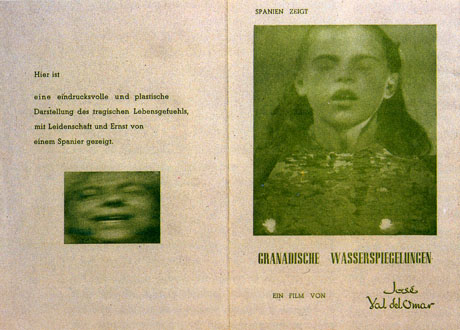| Berlin 1956 |
Granada is East and West.
Thus far the Germanic stones extend, and there they meet Islam.
The columns of the Palace of Charles V, with the fountains of the Palacio del Agua in the Alhambra.
Granada is the product of two rivers of blood and of two cultures in a living encounter, and the Granada-born José Val del Omar, an Andalucian with Arabic roots, convinced of having found in Berlin a site well disposed to be sympathetic to his native soil, has made us conserve the Spanish fame of the lands of the south, there where Europe ends, because Berlin in its turn stands on the via crucis between East and West.
This is an intimate, lyrical message, communicated by way of an original and own hearing, plastic and impressive.
Spain proposes a mecha-mystic action in opposition to Neorealism. It is not content with reality, or willing to stop at the frontiers of the mystery. In opposition to the electric light beam of the television with its wide-ranging reporting of the present, this director wants the magic lantern of the cinema to go beyond the panoramic screen and situate the horizon of its great collective visual field at the central point of the infinite. Having seen how far our present-day visual field has been expanded, in terms not only of space but also of time, the director raises our common point of view, so that the devastation wrought by time does not affect film. We look above the times so that man may discover and harmonize with the new reason and the logic of the atomic age without frontiers, without distances or restrictions.
José Val del Omar is a man of a profound inner perfection unknown in the world today: a world in which there is no place for the multi-faceted personality, in which an artist and a technician are two different things. He represents a return to the Greek techné. He is the sole author of the work he shows us. He was responsible for the poetic motive, the photography, the editing and every aspect of the sound.
Diaphonic sound, which is in total contrast to stereophonic sound, uses two different sound sources. The first source is the screen, the real document that is transmitted to the spectator. The second source, in contrast to the first, is located behind the audience and serves to convey a subjective sound of echoes and reflections that react to the voices of the interior and rise by the blood, manifesting themselves in the spectator's consciousness.
The axis of diaphony contrasts sharply with the stereophony that our ears perceive. The axis of diaphony corresponds to the concept of ''sentimental projection'' in German aesthetics.
Aguaespejo granadino shows us the familiar Siguiriya, the contemporary dance of the blind creatures that seek the support of the earth. The austere photography in black and white and the uncompromisingly primitive editing are complemented by an extraordinary technique that, in this case, is the perfect crystallization of the film's substance. The fountain reflects the life of man. The illusion grows with slow monotony in the interior of the human being and produces a hard elementary reality that overwhelms us externally. Our existence, under the hard conditions of life, is a dream of failures in a cage configured, as they say, by the fallen in this valley of differences. The human being sights the end. When we love our neighbour, we survive.
Here is
an impressive plastic sample
of the tragic sense of life
realized with passion and rigour by a Spaniard.

^ | | | Berlin 1956 |
| Brussels 1958 |
|